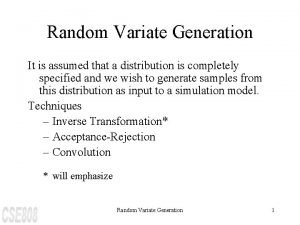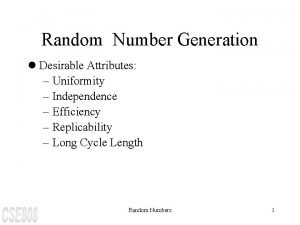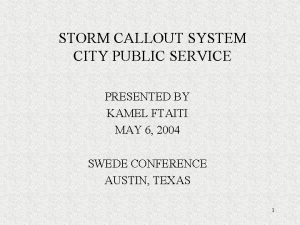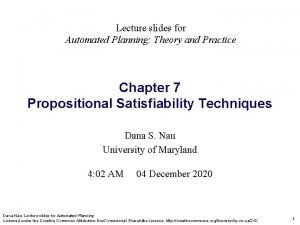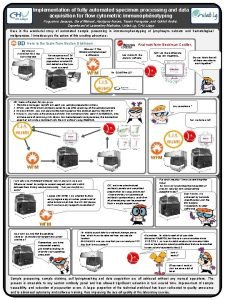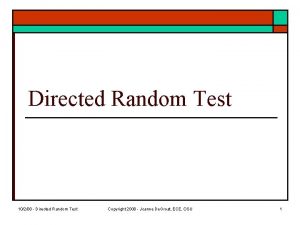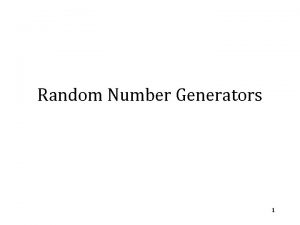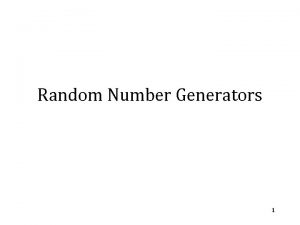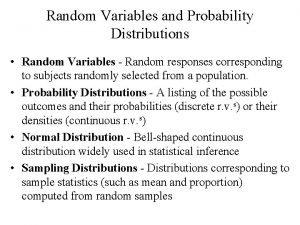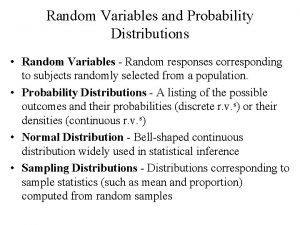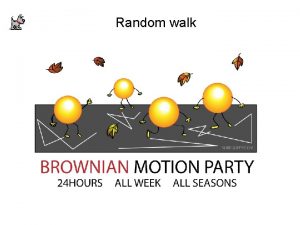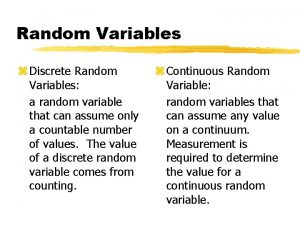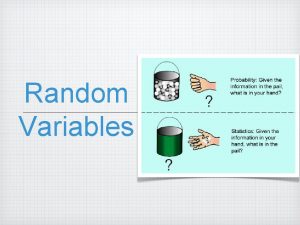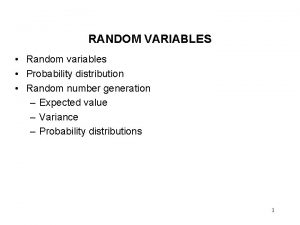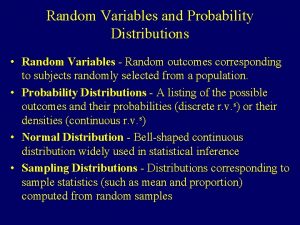Automated Test Generation CS 6340 Outline Previously Random


















































- Slides: 50

Automated Test Generation CS 6340

Outline • Previously: Random testing (Fuzzing) – Security, mobile apps, concurrency • Systematic testing: Korat – Linked data structures • Feedback-directed random testing: Randoop – Classes, libraries

Korat • A test-generation research project • Idea – Leverage pre-conditions and post-conditions to generate tests automatically • But how?

The Problem • There are infinitely many tests – Which finite subset should we choose? • And even finite subsets can be huge • Need a subset which is: – concise: Avoids illegal and redundant tests – diverse: Gives good coverage

An Insight • Often can do a good job by systematically testing all inputs up to a small size • Small Test Case Hypothesis: – If there is any test that causes the program to fail, there is a small such test • If a list function works for lists of length 0 through 3, probably works for all lists – E. g. , because the function is oblivious to the length

How Do We Generate Test Inputs? • Use the types class Binary. Tree { Node root; class Node { Node left; Node right; } } • The class declaration shows what values (or null) can fill each field • Simply enumerate all possible shapes with a fixed set of Nodes

Scheme for Representing Shapes • Order all possible values of each field • Order all fields into a vector • Each shape == vector of field values e. g. : Binary. Tree of up to 3 Nodes: root N 0 left right N 1 left right N 2 left right class Binary. Tree { Node root; class Node { Node left; Node right; } }

QUIZ: Representing Shapes Fill in the field values in each vector to represent the depicted shape: root N 0 left right N 1 left right N 2 left right N 0 N 1 N 2

QUIZ: Representing Shapes Fill in the field values in each vector to represent the depicted shape: root N 0 left right N 1 N 2 N 1 left right N 2 left right null N 0 null N 1 N 2 N 0 N 1 null N 2 null N 1 N 2

A Simple Algorithm • User selects maximum input size k • Generate all possible inputs up to size k • Discard inputs where pre-condition is false • Run program on remaining inputs • Check results using post-condition

QUIZ: Enumerating Shapes Korat represents each input shape as a vector of the following form: root N 0 left right N 1 left right N 2 left right What is the total number of vectors of the above form?

QUIZ: Enumerating Shapes Korat represents each input shape as a vector of the following form: root N 0 left right N 1 left right N 2 left right What is the total number of vectors of the above form? 16384

The General Case for Binary Trees • How many binary trees are there of size <= k? • Calculation: – A Binary. Tree object, bt – k Node objects, n 0, n 1, n 2, … – 2 k+1 Node pointers • • class Binary. Tree { Node root; class Node { Node left; Node right; } } root (for bt) left, right (for each Node object) – k+1 possible values (n 0, n 1, n 2, … or null) per pointer • (k+1)^(2 k+1) possible “binary trees”

A Lot of “Trees” ! • The number of “trees” explodes rapidly – k = 3: over 16, 000 “trees” – k = 4: over 1, 900, 000 “trees” – k = 5: over 360, 000 “trees” • Limits us to testing only very small input sizes • Can we do better?

An Overestimate • (k+1)^(2 k+1) trees is a gross overestimate! • Many of the shapes are not even trees: • And many are isomorphic: N 0 N 1 N 2 N 0 N 1

How Many Trees? Only 9 distinct binary trees with at most 3 nodes

Another Insight • Avoid generating inputs that don’t satisfy the pre-condition in the first place • Use the pre-condition to guide the generation of tests

The Technique • Instrument the pre-condition – Add code to observe its actions – Record fields accessed by the pre-condition • Observation: – If the pre-condition doesn’t access a field, then pre-condition doesn’t depend on the field.

The Pre-Condition for Binary Trees • Root may be null • If root is not null: class Binary. Tree { Node root; class Node { Node left; Node right; } } – No cycles – Each node (except root) has one parent – Root has no parent

The Pre-Condition for Binary Trees class Binary. Tree { Node root; class Node { Node left; Node right; } } public boolean rep. OK(Binary. Tree bt) { if (bt. root == null) return true; Set visited = new Hash. Set(); List work. List = new Linked. List(); visited. add(bt. root); work. List. add(bt. root); while (!work. List. is. Empty()) { Node current = work. List. remove. First(); if (current. left != null) { if (!visited. add(current. left)) return false; work. List. add(current. left); }. . . // similarly for current. right } return true; }

The Pre-Condition for Binary Trees class Binary. Tree { Node root; class Node { Node left; Node right; } } public boolean rep. OK(Binary. Tree bt) { if (bt. root == null) return true; Set visited = new Hash. Set(); List work. List = new Linked. List(); visited. add(bt. root); work. List. add(bt. root); while (!work. List. is. Empty()) { Node current = work. List. remove. First(); if (current. left != null) { if (!visited. add(current. left)) return false; work. List. add(current. left); }. . . // similarly for current. right } return true; } N 0 N 1 N 2

Example: Using the Pre-Condition • Consider the following “tree”: N 0 root N 0 left right N 1 left right N 2 left right null N 1 N 2 null • The pre-condition accesses only the root as it is null => Every possible shape for other nodes yields same result => This single input eliminates 25% of the tests!

Enumerating Tests • Shapes are enumerated by their associated vectors – Initial candidate vector: all fields null – Next shape generated by: • Expanding last field accessed in pre-condition • Backtracking if all possibilities for a field are exhausted • Key idea: Never expand parts of input not examined by pre-condition • Also: Cleverly checks for and discards shapes isomorphic to previously-generated shapes

Example: Enumerating Binary Trees root N 0 left right N 1 left right N 2 left right null null N 0 null null 1 2 3 N 0 null null N 0 null N 1 null 1 2 3 4 5 null 1

QUIZ: Enumerating Binary Trees What are the next two legal, non-isomorphic shapes Korat generates? root N 0 left right N 1 left right N 0 null N 1 null 1 2 3 4 5 N 2 left right null

QUIZ: Enumerating Binary Trees What are the next two legal, non-isomorphic shapes Korat generates? root N 0 left right N 1 left right N 0 null N 1 null 1 2 3 4 5 N 0 null N 1 null N 2 1 2 3 4 5 N 0 null N 1 N 2 null N 2 left right null 6 null 7 null

QUIZ: Enumerating Binary Trees What are the next two legal, non-isomorphic shapes Korat generates? root N 0 left right null N 1 left right N 2 null N 2 left right null

QUIZ: Enumerating Binary Trees What are the next two legal, non-isomorphic shapes Korat generates? root N 0 left right N 1 left right N 2 left right N 0 null N 1 N 2 null 1 2 3 4 7 5 6 N 0 N 1 null null 1 2 5 3 4 N 0 N 1 N 2 null

Experimental Results

Strengths and Weaknesses • Strong when we can enumerate all possibilities – e. g. Four nodes, two edges per node => Good for: • Linked data structures • Small, easily specified procedures • Unit testing • Weaker when enumeration is weak – Integers, Floating-point numbers, Strings

Weaknesses Only as good as the pre- and post-conditions Pre: is_member(x, list) List remove(Element x, List list) { if (x == head(list)) return tail(list); else return cons(head(list), remove(x, tail(list))); } Post: !is_member(x, list’)

Weaknesses Only as good as the pre- and post-conditions Pre: !is_empty(list) List remove(Element x, List list) { if (x == head(list)) return tail(list); else return cons(head(list), remove(x, tail(list))); } Post: is_list(list’)

Feedback-Directed Random Testing How do we generate a test like this? public static void test() { Linked. List l 1 = new Linked. List(); Object o 1 = new Object(); l 1. add. First(o 1); Tree. Set t 1 = new Tree. Set(l 1); Set s 1 = Collections. unmodifiable. Set(t 1); // This assertion fails assert(s 1. equals(s 1)); }

Overview Problem with uniform random testing: Creates too many illegal or redundant tests Idea: Randomly create new test guided by feedback from previously created tests test == method sequence Recipe: • Build new sequences incrementally, extending past sequences • As soon as a sequence is created, execute it • Use execution results to guide test generation towards sequences that create new object states

Randoop: Input and Output Input: Output: • classes under test • time limit • set of contracts e. g. “o. hash. Code() throws no exception” e. g. “o. equals(o) == true” • contract-violating test cases Linked. List l 1 = new Linked. List(); Object o 1 = new Object(); l 1. add. First(o 1); Tree. Set t 1 = new Tree. Set(l 1); Set s 1 = Collections. unmodifiable. Set(t 1); assert(s 1. equals(s 1)); No contract violated up to here fails when executed

Randoop Algorithm components = { int i = 0; , boolean b = false; . . . } // seed components Repeat until time limit expires: • Create a new sequence – Randomly pick a method call Tret m(T 1, . . . , Tn) – For each argument of type Ti, randomly pick sequence Si from components that constructs an object vi of that type – Create Snew = S 1; . . . ; Sn; Tret vnew = m(v 1. . . vn); • Classify new sequence Snew: discard / output as test / add to components

Classifying a Sequence execute sequence illegal? Yes Discard sequence Yes Output sequence Yes Discard sequence No contract violated? No Add to components No sequence redundant?

Illegal Sequences • Sequences that “crash” before contract is checked – E. g. throw an exception int i = -1; Date d = new Date(2006, 2, 14); d. set. Month(i); // pre: argument >= 0 assert(d. equals(d));

Redundant Sequences • Maintain set of all objects created in execution of each sequence • New sequence is redundant if each object created during its execution belongs to above set (using equals to compare) • Could also use more sophisticated state equivalence methods Set s = new Hash. Set(); s. add(“hi”); s. is. Empty(); assert. True(s. equals(s));

Some Errors Found by Randoop • JDK containers have 4 methods that violate o. equals(o) contract • Javax. xml creates objects that cause hash. Code and to. String to crash, even though objects are well-formed XML constructs • Apache libraries have constructors that leave fields unset, leading to NPE on calls of equals, hash. Code, and to. String • . Net framework has at least 175 methods that throw an exception forbidden by the library specification (NPE, out-of-bounds, or illegal state exception) • . Net framework has 8 methods that violate o. equals(o) contract

QUIZ: Randoop Test Generation (Part 1) Write the smallest sequence that Randoop can possibly generate to create a valid Binary. Tree. Once generated, how does Randoop classify it? Discards it as illegal Outputs it as a bug Adds to components for future extension class Binary. Tree { Node root; public Binary. Tree(Node r) { root = r; assert(rep. Ok(this)); } public Node remove. Root() { assert(root != null); . . . } } class Node { Node left; Node right; public Node(Node l, Node r) { left = l; right = r; } }

QUIZ: Randoop Test Generation (Part 1) Write the smallest sequence that Randoop can possibly generate to create a valid Binary. Tree bt = new Binary. Tree(null); Once generated, how does Randoop classify it? Discards it as illegal Outputs it as a bug Adds to components for future extension class Binary. Tree { Node root; public Binary. Tree(Node r) { root = r; assert(rep. Ok(this)); } public Node remove. Root() { assert(root != null); . . . } } class Node { Node left; Node right; public Node(Node l, Node r) { left = l; right = r; } }

QUIZ: Randoop Test Generation (Part 2) Write the smallest sequence that Randoop can possibly generate that violates the assertion in remove. Root(). Once generated, how does Randoop classify it? Discards it as illegal Outputs it as a bug Adds to components for future extension class Binary. Tree { Node root; public Binary. Tree(Node r) { root = r; assert(rep. Ok(this)); } public Node remove. Root() { assert(root != null); . . . } } class Node { Node left; Node right; public Node(Node l, Node r) { left = l; right = r; } }

QUIZ: Randoop Test Generation (Part 2) Write the smallest sequence that Randoop can possibly generate that violates the assertion in remove. Root(). Binary. Tree bt = new Binary. Tree(null); bt. remove. Root(); Once generated, how does Randoop classify it? Discards it as illegal Outputs it as a bug Adds to components for future extension class Binary. Tree { Node root; public Binary. Tree(Node r) { root = r; assert(rep. Ok(this)); } public Node remove. Root() { assert(root != null); . . . } } class Node { Node left; Node right; public Node(Node l, Node r) { left = l; right = r; } }

QUIZ: Randoop Test Generation (Part 3) Write the smallest sequence that Randoop can possibly generate that violates the assertion in Binary. Tree’s constructor. Can Randoop create a Binary. Tree object with cycles using the given API? Yes No class Binary. Tree { Node root; public Binary. Tree(Node r) { root = r; assert(rep. Ok(this)); } public Node remove. Root() { assert(root != null); . . . } } class Node { Node left; Node right; public Node(Node l, Node r) { left = l; right = r; } }

QUIZ: Randoop Test Generation (Part 3) Write the smallest sequence that Randoop can possibly generate that violates the assertion in Binary. Tree’s constructor. v 2 v 1 Node v 1 = new Node(null, null); Node v 2 = new Node(v 1, v 1); Binary. Tree bt = new Binary. Tree(v 2); Can Randoop create a Binary. Tree object with cycles using the given API? Yes No class Binary. Tree { Node root; public Binary. Tree(Node r) { root = r; assert(rep. Ok(this)); } public Node remove. Root() { assert(root != null); . . . } } class Node { Node left; Node right; public Node(Node l, Node r) { left = l; right = r; } }

QUIZ: Korat and Randoop Identify which statements are true for each test generation technique: Korat Uses type information to guide test generation. Each test is generated fully independently of past tests. Generates tests deterministically. Suited to test method sequences. Avoids generating redundant tests. Randoop

QUIZ: Korat and Randoop Identify which statements are true for each test generation technique: Korat Uses type information to guide test generation. Each test is generated fully independently of past tests. Generates tests deterministically. Suited to test method sequences. Avoids generating redundant tests. Randoop

Test Generation: The Bigger Picture • Why didn’t automatic test generation become popular decades ago? • Belief: Weak-type systems – Test generation relies heavily on type information – C, Lisp just didn’t provide the needed types • Contemporary languages lend themselves better to test generation – Java, UML

What Have We Learned? • Automatic test generation is a good idea – Key: avoid generating illegal and redundant tests • Even better, it is possible to do – At least for unit tests in strongly-typed languages • Being adopted in industry – Likely to become widespread
 Dfd 6340
Dfd 6340 Cs 6340
Cs 6340 Randoop automatic test
Randoop automatic test Automated generation and analysis of attack graphs
Automated generation and analysis of attack graphs Sglib1
Sglib1 First generation antipsychotics vs second
First generation antipsychotics vs second You are good and your mercy
You are good and your mercy Random variate
Random variate Random assignment vs random sampling
Random assignment vs random sampling Random assignment vs random selection
Random assignment vs random selection Kingdom archaebacteria (previously monera) nutrition
Kingdom archaebacteria (previously monera) nutrition What thailand was previously known as
What thailand was previously known as Rsro ncaa
Rsro ncaa Csun mse 227
Csun mse 227 Automated in circuit test
Automated in circuit test Bread sentence
Bread sentence Poker test for random numbers
Poker test for random numbers Random number test suite
Random number test suite Wordpress deployment automation
Wordpress deployment automation Automated exam marking
Automated exam marking Cimpap
Cimpap Automated callout system
Automated callout system Owasp
Owasp Automated certificate of eligibility
Automated certificate of eligibility Regional automated property information database
Regional automated property information database Digi payment kiosk
Digi payment kiosk Automated valuation service
Automated valuation service Evaluation through user participation in hci
Evaluation through user participation in hci Automated+electrophoresis+system
Automated+electrophoresis+system Automated grading sheet excel
Automated grading sheet excel Automated build process
Automated build process Semi auto analyzer principle
Semi auto analyzer principle Automatic vehicle locator system
Automatic vehicle locator system Ataspas
Ataspas Sitecore automated testing
Sitecore automated testing Automated surface observing system
Automated surface observing system Automated protein crystallization
Automated protein crystallization Automated production lines
Automated production lines Software aldep
Software aldep Ace cargo release error codes
Ace cargo release error codes Eg-ach
Eg-ach Automated certificate management environment
Automated certificate management environment Sr 71 star tracker
Sr 71 star tracker Tactical power supplies
Tactical power supplies Automated survey analysis
Automated survey analysis Automated surface observing system
Automated surface observing system Automated surface observing system
Automated surface observing system Pay per use monitor
Pay per use monitor Automated time and attendance payroll system
Automated time and attendance payroll system Automated planning theory and practice
Automated planning theory and practice Aurore tassin
Aurore tassin







